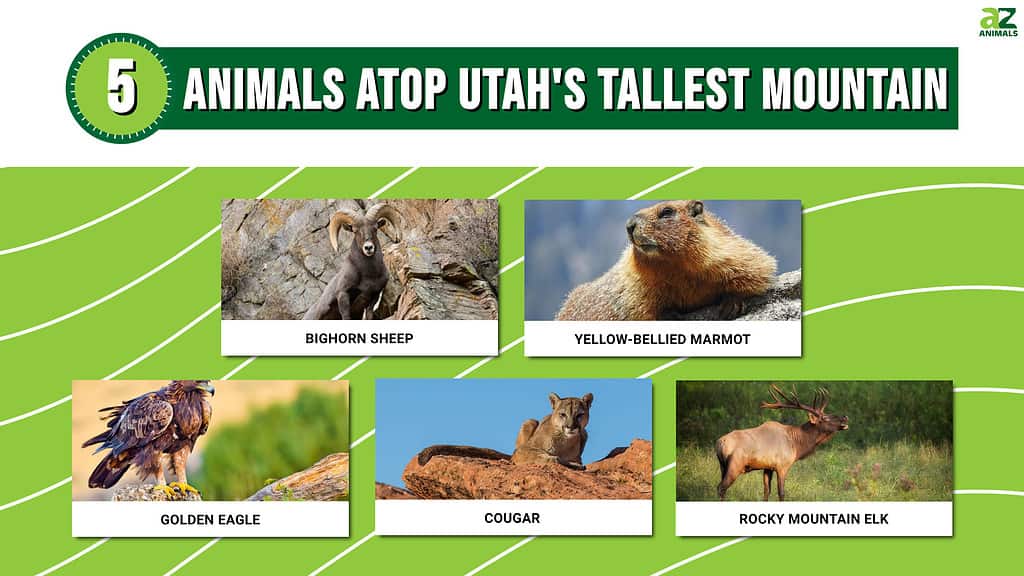
Residents and visitors alike know Utah for its incredible natural diversity. The state is home to arid deserts, lush pine forests, and majestic mountains. Several mountain ranges run through the state, including the Uinta Mountains in northeastern Utah. This east-to-west mountain chain contains numerous tall peaks, including the highest point in the state, Kings Peak. Many mountaineers scale to the summit of Kings Peak every year to enjoy its breathtaking views. Along with amazing views of the surrounding landscape, climbers often catch a glimpse of the local wildlife that call the mountain home. That said, what sort of animals live on top of Kings Peak? Keep reading to learn about 5 animals that roam atop Utah’s tallest mountain.
Background on Kings Peak

Kings Peak is the tallest mountain in Utah.
©Mitch Johanson/Shutterstock.com
With an elevation of 13,528 feet, Kings Peak ranks as the highest peak in the state of Utah. Kings Peak resides within the Ashley National Forest just south of the central spine of the Uinta Mountains. It lies approximately 45 miles north of the town of Duchesne and 79 miles east of Salt Lake City. The mountain shares its name with Clarence King, the first director of the United States Geological Survey, who surveyed the area in the late 19th century.
You can scale Kings Peak via one of three major routes. The “easiest” of these routes consists of a 29-mile round trip hike up the peak’s southern slope. On the other hand, you could try to scale the peak’s eastern slope or hike up its northern ridge. Many climbers rank Kings Peak as the hardest state highpoint to scale that doesn’t require ice or rock-climbing experience.
Animals on Kings Peak
The Uintas Mountains are home to a wide variety of mammals, birds, and fish. While some of these creatures migrate to and from the mountains, others live on their rugged cliffs year-round.
Climbers frequently report spotting wildlife during their hike from the base to the summit of Kings Peak. Some animals that you can encounter during the ascent include bears, mountain goats, moose, birds of prey, and pine martens.
Kings Peak is home to so many different creatures. Let’s take a look at 5 animals that roam atop Utah’s tallest mountain.
5. Bighorn Sheep
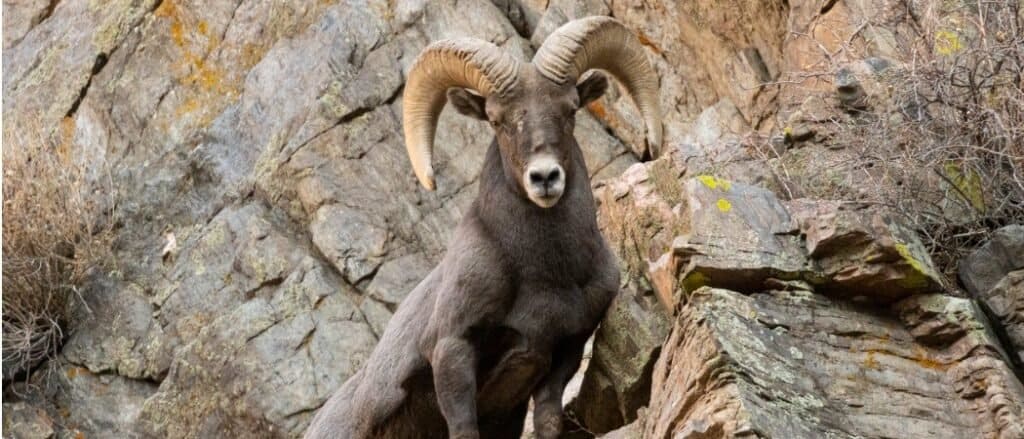
Bighorn sheep grow large, curved horns.
©iStock.com/SWKrullImaging
The bighorn sheep (Ovis canadensis) likely ranks as Kings Peak’s most visible mountain resident. This native North American sheep species ranges throughout the western half of the United States, Canada, and the Baha California peninsula. Bighorn sheep typically inhabit rocky cliffs, grassy mountain meadows, and rugged lowland areas.
On average, bighorn sheep range from 75 to 315 pounds, with males typically weighing more than females. In terms of length, they stand between 30 and 41 inches tall and measure between 50 and 73 inches long. Their coats vary from light to dark brown as well as gray, and they often feature a white patch on the rump and the backs of the legs. Bighorn sheep get their name from the large, curved horns of the males (rams). Female bighorn sheep also sport horns, but their horns appear much smaller and less curved.
Bighorn sheep live in large herds, typically led by a single dominant male. Males use their horns to fight with one another and to establish dominance within the group hierarchy. Herds roam across mountain landscapes, which they can navigate thanks to their gnarled, bony hooves. You can often see herds of bighorn sheep grazing on shrubs or grasses atop Kings Peak.
4. Yellow-Bellied Marmot
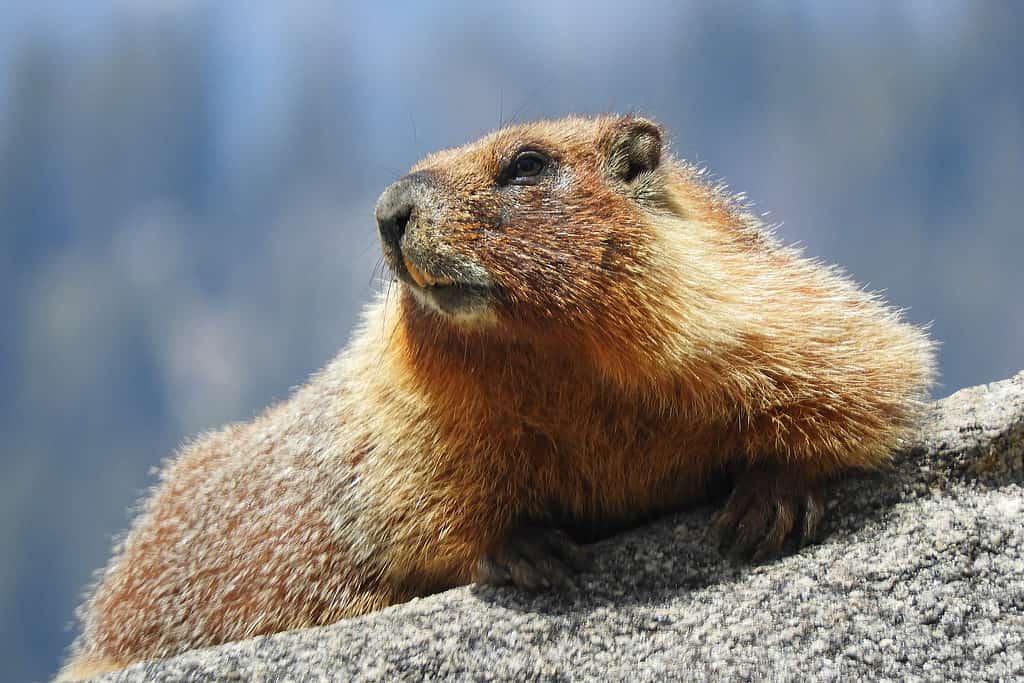
Yellow-bellied marmots spend most of their time in their burrows.
©AustralianCamera/Shutterstock.com
The yellow-bellied marmot (Marmota flaviventris) also goes by the name the rock chuck. This large species of ground squirrel belongs to the marmot genus Marmota. You can find yellow-bellied marmots throughout mountain areas in the western United States and southern Canada.
Most adult yellow-bellied marmots weigh between 3 pounds, 8 ounces, and 11 pounds, 7 ounces, with males usually weighing more than females. They measure 17.5 to 27 inches long and sport a relatively short tail measuring 5 to 8.5 inches long. Yellow-bellied marmots have a mostly brown coat with a white patch on the snout and between the eyes. That said, they grow yellow hairs on the side of the neck, throat, and belly, hence their name.
Yellow-bellied marmots live in groups known as colonies. A single colony can contain anywhere from 10 to 20 individual marmots. Yellow-bellied marmots are polygynous, meaning that a single male will typically mate with multiple females. They spend most of their lives in their burrows, either resting or hibernating. During the day, you can sometimes see yellow-bellied marmots standing outside their burrows on the rocky slopes of Kings Peak.
3. Golden Eagle
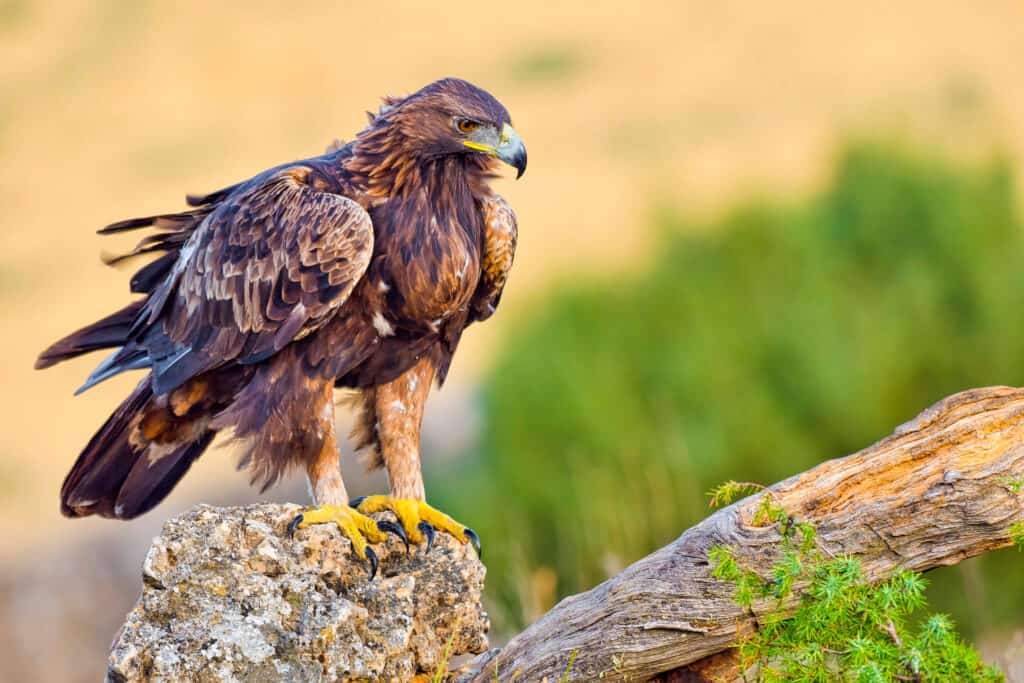
Golden eagles are prolific hunters, capable of catching both large and small mammals, as well as other birds.
©Al Carrera/Shutterstock.com
The golden eagle (Aquila chrysaetos) is one of two eagles found in Utah, the other being the bald eagle. Golden eagles are widely distributed throughout the Northern Hemisphere. Although they can live in a wide variety of habitats, they frequently live in mountainous, open regions.
Generally speaking, golden eagles measure between 26 and 40 inches long and sport a wingspan between 5 feet, 11 inches, and 7 feet, 8 inches. Females typically measure larger than males in terms of both length and weight. Golden eagles get their name from the bright golden feathers on the head and neck. The rest of the feathers appear primarily dark brown, with some gray feathers on the tail and inner wing.
Golden eagles are prolific hunters, capable of catching both large and small mammals, as well as other birds. They normally mate for life and build their nests on rocky cliffs. Many cultures around the world have long revered golden eagles for their strength and striking appearance. During your next trip to Kings Peak, see if you can spot golden eagles soaring above the mountain.
2. Cougar
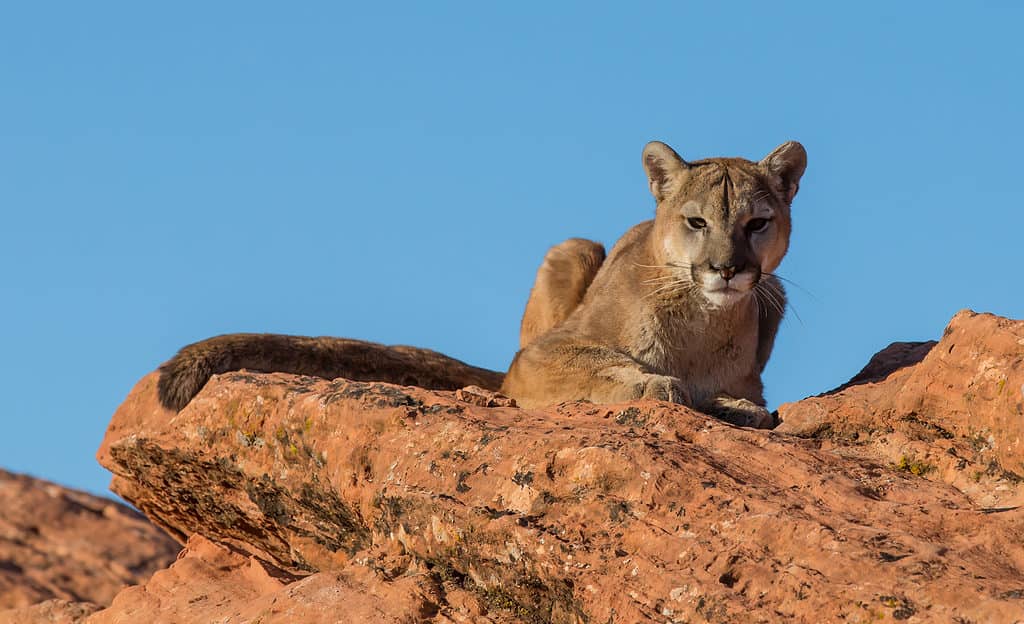
The cougar ranks as the fourth-largest cat in the world.
©Warren Metcalf/Shutterstock.com
Also known as the mountain lion or puma, the cougar (Felis concolor) is one of two big cats found in the Americas, the other being the jaguar. It ranges throughout North and South America, primarily in mountainous or rocky habitats with dense cover.
Cougars rank as the fourth-largest cats in the world. They usually stand between 24 and 35 inches tall and measure between 5 and 9 feet long. Males typically measure heavier and larger than females, with most specimens weighing between 75 and 160 pounds. That said, some larger cougars tip the scales at over 200 pounds. They possess large, round heads, large paws, and relatively long legs. Most cougars have rather plain coloring, appearing either light brown or beige.
Cougars eat a wide variety of prey, including deer, bighorn sheep, mountain goats, large rodents, and birds. These notoriously shy and secretive cats tend to keep far away from humans. They control large territories, which usually helps them to avoid humans. However, you could still encounter a cougar during a hike up Kings Peak.
1. Rocky Mountain Elk
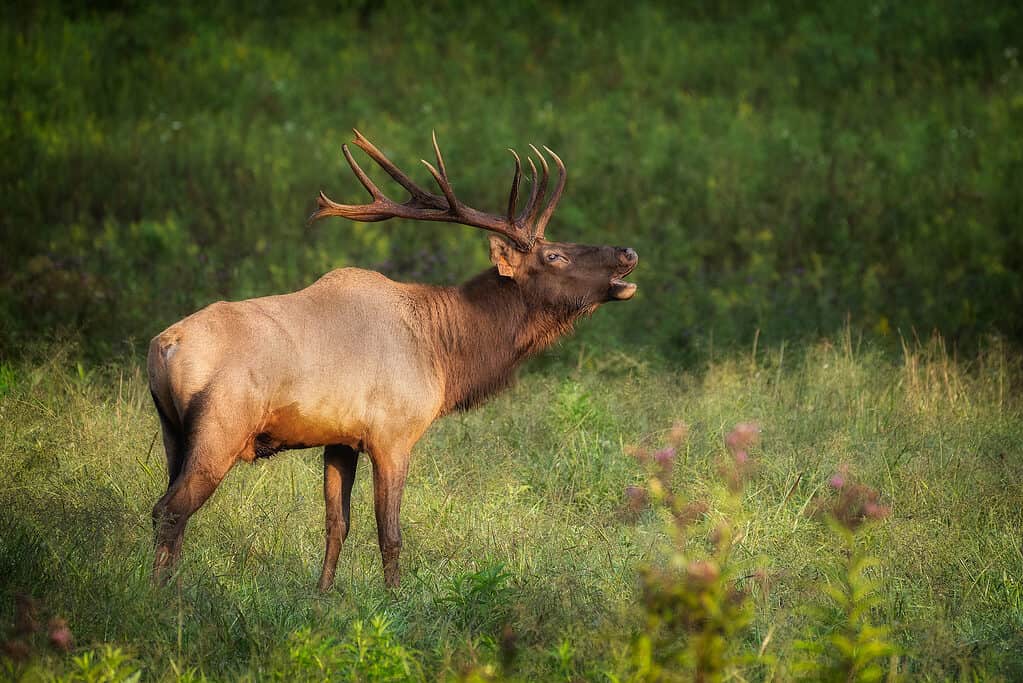
Rocky Mountain elk males usually weigh from 400 to 1,000 pounds.
©iStock.com/MattCuda
The Rocky Mountain elk (Cervus canadensis nelsoni) is a subspecies of elk in the deer family Cervidae. It represents the only subspecies of elk found in Utah. Rocky Mountain elk usually live in alpine forests and basins in the summer and lowland forests and marshes in the winter.
Rocky Mountain elk vary between 5 and 9 feet long, with males measuring larger than females. Males usually weigh from 400 to 1,000 pounds, while females measure between 370 and 650 pounds. Like other subspecies of elk, they possess long, slender legs, short tails, and large antlers made of bone. They grow a thick coat made of hair that appears light brown on the body and darker brown around the head, neck, and legs.
Rocky Mountain elk live in large herds. Outside of the mating season, female and male elk live in separate groups. While they primarily graze on grasses, they may also browse for shrubs, leaves, and woody plants. They are a common sight along Kings Peak, particularly during the summer months.
Plants on Kings Peak
The plant life on Kings Peak varies depending on the elevation. Above the timberline (around 11,500 feet), you can mostly find small, fast-growing flowers. Common flowers near the peak of Kings Peak include forget-me-nots, moss campions, Indian paintbrush, alpine avens, and harebells.
Just below the timberline, you can find upper montane vegetation. This region extends from around 11,500 feet to 9,500 feet above sea level. In this region, you can find hardy pine, fir, and aspen trees. Other plants in the upper montane include colorful flowers such as larkspur, mountain bells, and daisies.
The lower montane region lies below the upper montane. It extends from around 6,200 feet to 9,500 feet above sea level. Plants in the lower montane resemble plants in the upper montane. However, you can find an even wider variety of trees in the lower montane, including ash, willows, maple, and countless varieties of flowers.
Summary of the 5 Animals Atop Utah’s Tallest Mountain
Here are the 5 Animals Atop Utah’s Tallest Mountain:
| Rank | Animals |
|---|---|
| 1 | Bighorn Sheep |
| 2 | Yellow-Bellied Marmot |
| 3 | Golden Eagle |
| 4 | Cougar |
| 5 | Rocky Mountain Elk |
The photo featured at the top of this post is © Jeremy Christensen/Shutterstock.com
Thank you for reading! Have some feedback for us? Contact the AZ Animals editorial team.







